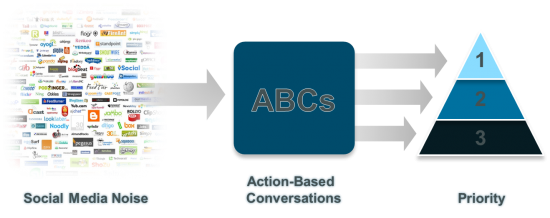The Greek philosopher Epictetus once said, “We have two ears and one mouth so that we can listen twice as much as we speak.” This is an important adage to embrace, especially with social media marketing programs. Listening enables you to understand what people expect from your brand and how they feel about your products. It can also give you valuable insights to guide your strategy and develop deeper, more meaningful relationships with your customers.
All too often, a common failure with brands is that they speak twice as much as they listen – or worse yet, they don’t listen at all:
- 56% of customer tweets to companies are being ignored (source)
- 70% of brands ignore complaints on Twitter (source)
- 39% of companies do not track their social media responses at all, and 55% ignore all customer feedback on Twitter and Facebook, largely because they have no process in place to respond (source)
Companies who fail to listen are losing an opportunity to satisfy and engage customers, and they also miss out on other strategic benefits. Listening delivers great value during the strategic planning process as well as in tactical operations. It can help you:
- Identify emerging trends
- Provide competitive insights
- Discover product issues and concerns
- Manage crisis and mitigate risk
- Uncover sales leads
- Find influencers and advocates
- Guide your content marketing strategy
Sophisticated listening guides our approach at Cisco. We implemented a Social Media Listening Center (SMLC) to visualize conversations that are relevant to us. Our listening center started out as a single-screen display outside of our CMO’s office. Now, it is a multi-screen experience that enables customized visualizations in real time. It features conversations related to our brand, trends, influencers, and sentiment, as well as short-term activities such as new product launches, major campaigns/sponsorships, and our annual customer conference, Cisco Live.
But listening alone is not enough. Today’s social media savvy customers expect companies not only to listen, but also to respond. A study by Edison Research found that 67% of people want a response within 24 hours or less. This is where the “ABCs and 123s of Social Listening” comes into play.

Step 1: Action-Based Conversations (ABCs)
Cisco is mentioned 5-7K times a day and roughly 3% of those conversations are actionable. Using our listening tools, we developed a process to help filter out the noise and identify the ABCs. These conversations are then categorized into one of the six categories below:
- Support – Request for help resolving real-time issue
- Question – General inquiries and product questions
- Critic – Conversations that merit brand management consideration
- Buzz – Praise from Cisco fan or advocate
- Lead – Pronouncement of near-term purchase decision
- Idea – Request to enhance a product with a new feature
Step 2: 123s
After we identify and categorize the ABCs, we then prioritize them into 3 levels. Priority 1 conversations typically have a 24-hour response time, and priority 2 conversations have a 72-hour response time. Priority 3 conversations fall in the discretionary response category.
Step 3: Route and Respond
Once conversations are tagged, they are routed through our social content management platform to the appropriate team members and experts who can provide a response within the designated time frame.
Step 4: Measure and Evaluate
As with any marketing program, it’s extremely important to measure your results and set targets for success. At Cisco, we began by tracking baseline metrics such as the number of action-based conversations and replies. Now we also track reach, revenue from listening for leads, average response time and adherence to SLAs (i.e. response posted within the recommended time period). We monitor these performance indicators and make adjustments to the program as needed to ensure continued success for Cisco and our customers.
Listening isn’t always easy, but it’s well worth the effort. The more you listen and interact with those who are talking about your company, the greater opportunity you have to build connections and increase the visibility of your brand. Having a formal program in place to not only listen, but also respond offers many rewards ranging from increased customer satisfaction to positive brand perception to new revenue opportunities. Just remember your listening ABCs and 123s, and you will be well on your way to creating meaningful relationships with your customers.
It’s a great mistake not to listen and not being proactive with the customers needs…great key note to be shared. I agree with you 100%.